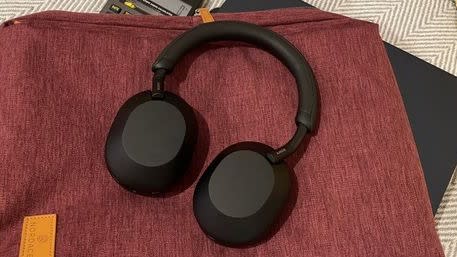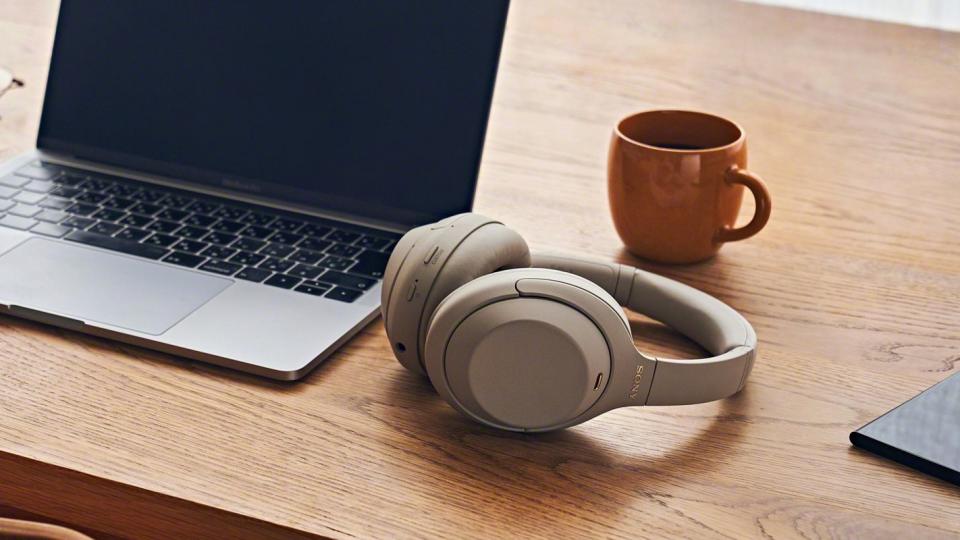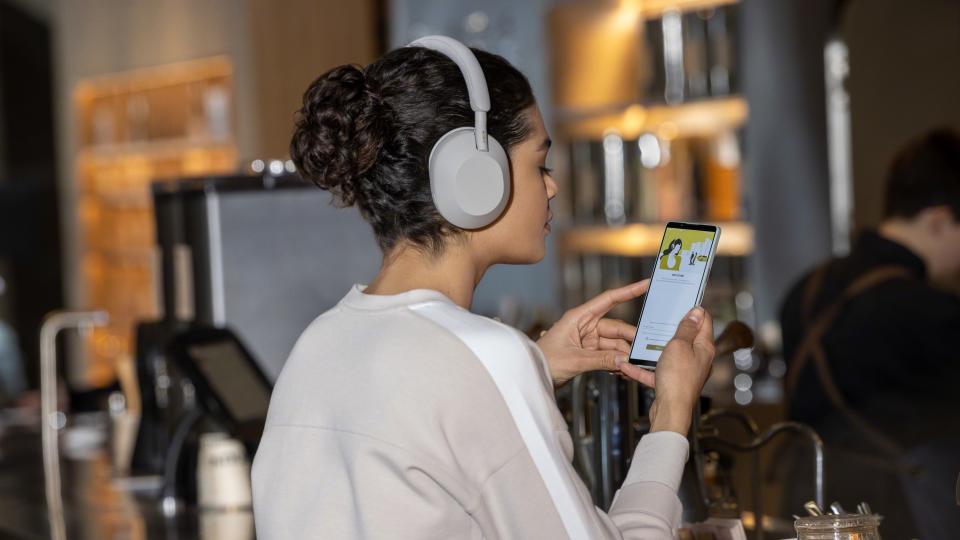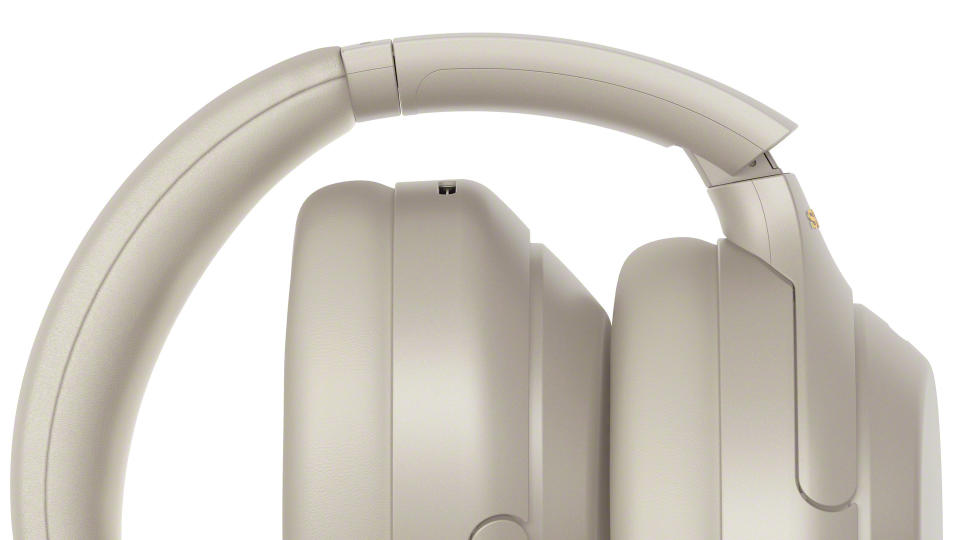Sony WH-1000XM5 vs WH-1000XM4: which headphones should you buy?


Sony WH-1000XM5
Bluetooth: SBC, AAC, LDAC
Battery life: 30hrs
Charging: USB-C
Weight: 250g
'If it ain't broke, don't fix it' goes the saying. Sony begs to differ, and with stunning results. It's brought on the sound quality of its best over-ear wireless headphones while executing a complete redesign. True, they feel a little less premium than their predecessors, but one listen will dispel all doubts. Simply incredible.
For
Sensational sonic clarity
Punchy delivery
Precise, agile bass
Nice to use
Against
Build seems a little less premium than before
Don’t fold away completely

Sony WH-1000XM4
Bluetooth: SBC, AAC, LDAC
Battery life: 30hrs
Charging: USB-C
Weight: 254g
Their successors might better them for sound quality, noise cancellation and features, but the XM4 are still mighty fine. They have a more premium build than the XM5, and can go toe to toe with any similarly priced pair, especially now they're discounted and coming to the end of their life. Still a great buy.
For
Dynamic, detail-rich sound
Sensational sense of timing
Lightweight, comfy and clever
Against
No IP rating
No aptX support
Now superseded by the XM5
Since launching in 2022, the Sony WH-1000XM5 have topped our list of best Bluetooth headphones. That's a sign of quality, but it was hardly unexpected – their predecessors, the Sony WH-1000XM4 did the same when they launched in 2020, right up until they were succeeded by the XM5.
Sony is on form (it did pull off a clean sweep of our headphone categories at the 2023 What Hi-Fi? Awards). But which pair is right for you? The newer, more feature-laden (but pricier) XM5? Or the older, cheaper XM4? Let's find out.
Sony WH-1000XM5 vs WH-1000XM4: price
The XM4 launched at £350 ($350, AU$550), but that was back in 2020. At time of writing (January 2024) they can be picked up for significantly less – in the UK, they are regularly priced around the £250 mark (though they have dropped as low as £199), $250 in the US and AU$350 or so in Australia. They're getting on a bit now though, so don't expect them to stick around forever.
The XM5 are, inevitably, more expensive. They launched at £380 / $399 / AU$549 in May 2022, and now sell for around £300 / $330 / AU$480. Everything seems to be getting more expensive nowadays, so this isn't a great surprise.
**Winner** Sony WH-1000XM4
See the best Sony WH-1000XM4 deals
B&W Px7 S2e vs Sony WH-1000XM5: which ANC headphones are for you?
Sony WH-1000XM5 vs WH-1000XM4: design

The first thing that strikes you about the XM5 is how different they look to their predecessors. The design has changed significantly, with a slimmer headband that has a stepless slider, making adjusting the fit a smooth motion. Instead of the usual swivel arm seen on the XM3 and XM4, the XM5's arm is exposed, with just a single contact point.
Because Sony has done away with these joints and hinges, the XM5 don't fold into a ball like the XM4. Instead, the headphones fold flat like the Bose Noise Cancelling Heaphones 700. While this makes them a little sleeker, it also makes them feel more delicate – and less premium than the sturdier XM4 – and you are more likely to use the supplied carry case to keep them safe. This is now collapsible to be made thinner but does still take up valuable space in a bag.
The 'Custom' button has now been relabelled 'NC/Ambient', but remains in the same place. It's likely Sony made this decision based on how people have been using the button.
Hoping for some inspiring colour options? You're out of luck. Sony's over-ears once again come in just black and silver although this time the XM5 get a lighter platinum silver finish compared to the previous version. If you're after something less sedate, you will have to look further afield.
The XM4 look a bit bulkier and clumsier by comparison. But the more rugged approach might appeal to anyone not wanting to bring a carry case along for every journey.
The XM5 are just as comfortable as the XM4 with the headband and memory-foam ear pads are covered in a new synthetic leather which is soft and smooth to the touch.
**Winner** Draw
Sony WH-1000XM5 vs WH-1000XM4: battery life

Before the WH-1000XM5 launched, rumours emerged of a longer battery life. The figure of 40 hours was bandied about, which would be a full 10 hours more than the 30 on offer from the XM4. Sadly, this isn't quite true.
While you can get 40 hours of use from the XM5, it's only under very specific conditions. Namely with noise-cancelling switched off and using a more efficient audio codec. That is an improvement of two hours over the 38 of the XM4, but for obvious reasons, Sony doesn't quote this as the standard battery life.
Instead, the XM5 gives you the same 30 hours of use as the XM4. That's with ANC switched on, using any audio codec, so represents real-world use for most people. It's a shame there's no improvement here, but 30 hours is still a very respectable figure.
**Winner** Sony WH-1000XM5
Sony WH-1000XM5 vs WH-1000XM4: features

The XM5 is largely more of the same – these headphones offer the same basic feature set as the WH-1000XM4, with just some slight improvements. There are no complaints about that here – the XM4, after all, are some of the best wireless headphones ever made. And the improvements are quite significant.
The noise-cancelling has generally been improved with additional microphones. The XM5 has two processors that control eight mics (up from five on the XM4) to neutralise background sound. Sony's HD Noise Cancelling Processor QN1 is aided by the Integrated Processor V1 (both previously seen on the XM4).
Just like the XM4, it supports Sony's hi-res LDAC music codec (but not aptX or aptX HD), DSEE Extreme (which upscales music files in real time), and Sony's 360 Reality Audio tech, giving you virtual surround sound.
The XM4's Adaptive Sound Control also makes a welcome return, with upgrades in tow. Adaptive Sound Control automatically adjusts the sound output depending on your situation – so it will detect if you are in a quiet meadow or a busy city street, for example, and tweak the audio accordingly. This is more advanced than the version found on the XM4, which relies on you running Sony’s NC Optimiser after you have changed surroundings to make sure you are getting the best noise-cancelling possible.
Adaptive Sound Control also recognises your most frequented locations, so if you do the same commute regularly, or visit the same gym, the headphones will quickly learn and adjust their sound to suit.
Quick Access lets you resume Spotify playback in two or three taps, without having to dig out your phone, and the Sony Headphones Connect app tells you if your listening volume is too high and could potentially damage your hearing. This is based on World Health Organisation data, so has a real grounding in science.
Speak-to-Chat is also back. This detects when you are talking, and pauses the music and lets in ambient sound, so you can have a conversation without taking the headphones off. Take them off, and they pause playback automatically, put them back on and it restarts – with this feature (called 'Wearing Detection'), they react slightly quicker than on the XM4. Hands-free controls come courtesy of Google Assistant and Amazon Alexa voice assistants.
Like the WH-1000XM4, the XM5 supports Multipoint, so can be wirelessly paired to two devices at once. Getting a call? They will know which device it's coming from and automatically connect you to it. And you can switch devices at the touch of a button.
Calls are clearer than ever, thanks to Sony's Precise Voice Pickup technology. With four beam-forming mics and AI-powered noise-reduction, plus wind-noise reduction, they do a great job of suppressing general noise and any gusts of wind that could threaten to drown you out when trying to use lesser headphones.
Google Fast Pair comes as standard too, for pairing quickly with Android devices, while Windows devices are catered for with Swift Pair.
All in all, it's quite a feature set, doing everything the XM4 can and then some.
**Winner** Sony WH-1000XM5
Sony WH-1000XM5 vs WH-1000XM4: sound quality

While it's all change with the 1000XM from a design point of view, you are probably hoping that not much has changed inside. The XM4 are some of the best-sounding over-ear headphones in their price bracket – surely to mess with the engine behind this supercar performance would be madness?
Sony disagrees. It has swapped out the 40mm driver used in the WH-1000XM4 with a new, 30mm carbon fibre composite dome that has been specially designed to be lightweight and extremely rigid.
And the XM5 are all the better for it.
Theirs is an entertaining and musical sound across all genres. Notable improvements? The WH-1000XM5 sound clearer and more open than previous models – and by a fair amount, too. They sound more precise in the low-end, making the XM4 sound a little thick by comparison. And they pick up a greater level of detail. It's no mean feat, considering the XM4 also deliver a five-star performance. The same is true higher up the frequency scale as the XM5 take a punchier, more dynamic approach to music.
The XM4 headphones still outclass any similarly priced rivals, though – they're still composed, confident performers even if the new(er) kid on the block has the edge.
**Winner** Sony WH-1000XM5
Sony WH-1000XM5 vs WH-1000XM4: verdict
So there you have it. While not a radical departure, the XM5 is an improvement on what were already the best wireless headphones around. Better sound quality, call quality and improved noise-cancelling, and a better design all make them a compelling buy for anyone with the funds.
And for anyone else, the XM4 are sure to drop even further in price. This is still a stellar pair of headphones that arguably feel more premium than the XM5, so keep a look out for a bargain. If you already own a pair there's no need to rush out and upgrade straight away.
MORE:
See our Sony WH-1000XM5 tips, tricks and FAQ answers
Read the full Sony WH-1000XM4 review
Sony WH-1000XM5 vs Bose Noise Cancelling Headphones 700: which are best?
Here are the best Sony headphones you can buy
